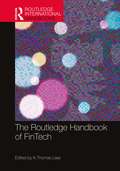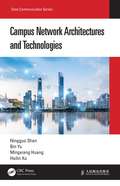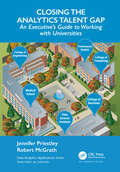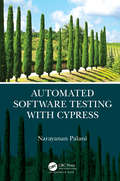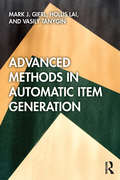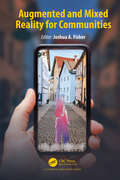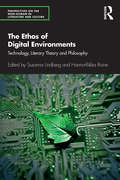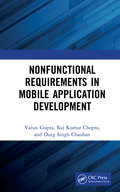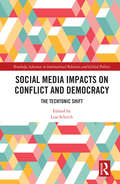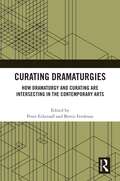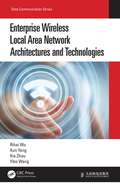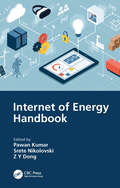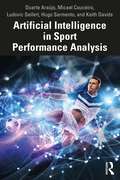- Table View
- List View
The Routledge Handbook of FinTech (Routledge International Handbooks)
by K. Thomas LiawThe Routledge Handbook of FinTech offers comprehensive coverage of the opportunities, challenges and future trends of financial technology. This handbook is a unique and in-depth reference work. It is organised in six thematic parts. The first part outlines the development, funding, and the future trends. The second focuses on blockchain technology applications and various aspects of cryptocurrencies. The next covers FinTech in banking. A significant element of FinTech, mobile payments and online lending, is included in the fourth part. The fifth continues with several chapters covering other financial services, while the last discusses ethics and regulatory issues. These six parts represent the most significant and overarching themes of FinTech innovations. This handbook will appeal to students, established researchers seeking a single repository on the subject, as well as policy makers and market professionals seeking convenient access to a one-stop guide.
Campus Network Architectures and Technologies (Data Communication Series)
by Ningguo Shen Bin Yu Mingxiang Huang Hailin XuCampus Network Architectures and Technologies begins by describing the service challenges facing campus networks, and then details the intent-driven campus network architectures and technologies of Huawei Cloud Campus Solution. After reading this book, you will have a comprehensive understanding of next-generation campus network solutions, technical implementations, planning, design, and other know-how. Leveraging Huawei’s years of technical expertise and practices in the campus network field, this book systematically describes the use of technical solutions such as virtualization, big data, AI, and SDN in campus networks. You will be able to reconstruct campus networks quickly and efficiently utilizing this informative description. Additionally, this book provides detailed suggestions for campus network design and deployment based on Huawei's extensive project implementation experience, assisting with the construction of automated and intelligent campus networks required to cope with challenges. This is a practical, informative, and easy-to-understand guide for learning about and designing campus networks. It is intended for network planning engineers, network technical support engineers, network administrators, and enthusiasts of campus network technologies. Authors Ningguo Shen is Chief Architect for Huawei’s campus network solutions. He has approximately 20 years' experience in campus network product and solution design, as well as a wealth of expertise in network planning and design. Mr. Shen previously served as a system engineer for the campus switch, data center switch, and WLAN product lines, and led the design of Huawei’s intent-driven campus network solution. Bin Yu is an Architect for Huawei's campus network solutions. He has 12 years’ experience in campus network product and solution design, as well as extensive expertise in network planning and design and network engineering project implementation. Mr. Yu once led the design of multiple features across various campus network solutions. Mingxiang Huang is a Documentation Engineer for Huawei’s campus network solutions. He has three years of technical service experience, and four years of expertise in developing campus network product documentation. Mr. Huang was previously in charge of writing manuals for Huawei router and switch products. He has authored many popular technical series, including Be an OSPF Expert, Insight into Routing Policies, and Story behind Default Routes. Hailin Xu is a Documentation Engineer for Huawei’s campus network solutions. He has two years of marketing experience in smart campus solutions, and six years of expertise in developing network products and solution documentation. Extremely familiar with Huawei's campus network products and solutions, Mr. Xu was previously in charge of writing manuals for Huawei routers, switches, and campus network solutions. In addition, he has participated in smart campus marketing projects within such sectors as education, government, and real estate.
Campus Network Architectures and Technologies (Data Communication Series)
by Ningguo Shen Bin Yu Mingxiang Huang Hailin XuCampus Network Architectures and Technologies begins by describing the service challenges facing campus networks, and then details the intent-driven campus network architectures and technologies of Huawei Cloud Campus Solution. After reading this book, you will have a comprehensive understanding of next-generation campus network solutions, technical implementations, planning, design, and other know-how. Leveraging Huawei’s years of technical expertise and practices in the campus network field, this book systematically describes the use of technical solutions such as virtualization, big data, AI, and SDN in campus networks. You will be able to reconstruct campus networks quickly and efficiently utilizing this informative description. Additionally, this book provides detailed suggestions for campus network design and deployment based on Huawei's extensive project implementation experience, assisting with the construction of automated and intelligent campus networks required to cope with challenges. This is a practical, informative, and easy-to-understand guide for learning about and designing campus networks. It is intended for network planning engineers, network technical support engineers, network administrators, and enthusiasts of campus network technologies. Authors Ningguo Shen is Chief Architect for Huawei’s campus network solutions. He has approximately 20 years' experience in campus network product and solution design, as well as a wealth of expertise in network planning and design. Mr. Shen previously served as a system engineer for the campus switch, data center switch, and WLAN product lines, and led the design of Huawei’s intent-driven campus network solution. Bin Yu is an Architect for Huawei's campus network solutions. He has 12 years’ experience in campus network product and solution design, as well as extensive expertise in network planning and design and network engineering project implementation. Mr. Yu once led the design of multiple features across various campus network solutions. Mingxiang Huang is a Documentation Engineer for Huawei’s campus network solutions. He has three years of technical service experience, and four years of expertise in developing campus network product documentation. Mr. Huang was previously in charge of writing manuals for Huawei router and switch products. He has authored many popular technical series, including Be an OSPF Expert, Insight into Routing Policies, and Story behind Default Routes. Hailin Xu is a Documentation Engineer for Huawei’s campus network solutions. He has two years of marketing experience in smart campus solutions, and six years of expertise in developing network products and solution documentation. Extremely familiar with Huawei's campus network products and solutions, Mr. Xu was previously in charge of writing manuals for Huawei routers, switches, and campus network solutions. In addition, he has participated in smart campus marketing projects within such sectors as education, government, and real estate.
Closing the Analytics Talent Gap: An Executive's Guide to Working with Universities (Data Analytics Applications)
by Jennifer Priestley Robert McGrathHow can we recruit out of your program? We have a project – how do we reach out to your students? If we do research together who owns it? We have employees who need to "upskill" in analytics – can you help me with that? How much does all of this cost? Managers and executives are increasingly asking university professors such questions as they deal with a critical shortage of skilled data analysts. At the same time, academics are asking such questions as: How can I bring a "real" analytical project in the classroom? How can I get "real" data to help my students develop the skills necessary to be a "data scientist? Is what I am teaching in the classroom aligned with the demands of the market for analytical talent? After spending several years answering almost daily e-mails and telephone calls from business managers asking for staffing help and aiding fellow academics with their analytics teaching needs, Dr. Jennifer Priestley of Kennesaw State University and Dr. Robert McGrath of the University of New Hampshire wrote Closing the Analytics Talent Gap: An Executive’s Guide to Working with Universities. The book builds a bridge between university analytics programs and business organizations. It promotes a dialog that enables executives to learn how universities can help them find strategically important personnel and universities to learn how they can develop and educate this personnel. Organizations are facing previously unforeseen challenges related to the translation of massive amounts of data – structured and unstructured, static and in-motion, voice, text, and image – into information to solve current challenges and anticipate new ones. The advent of analytics and data science also presents universities with unforeseen challenges of providing learning through application. This book helps both organizations with finding "data natives" and universities with educating students to develop the facility to work in a multi-faceted and complex data environment. .
Closing the Analytics Talent Gap: An Executive's Guide to Working with Universities (Data Analytics Applications)
by Jennifer Priestley Robert McGrathHow can we recruit out of your program? We have a project – how do we reach out to your students? If we do research together who owns it? We have employees who need to "upskill" in analytics – can you help me with that? How much does all of this cost? Managers and executives are increasingly asking university professors such questions as they deal with a critical shortage of skilled data analysts. At the same time, academics are asking such questions as: How can I bring a "real" analytical project in the classroom? How can I get "real" data to help my students develop the skills necessary to be a "data scientist? Is what I am teaching in the classroom aligned with the demands of the market for analytical talent? After spending several years answering almost daily e-mails and telephone calls from business managers asking for staffing help and aiding fellow academics with their analytics teaching needs, Dr. Jennifer Priestley of Kennesaw State University and Dr. Robert McGrath of the University of New Hampshire wrote Closing the Analytics Talent Gap: An Executive’s Guide to Working with Universities. The book builds a bridge between university analytics programs and business organizations. It promotes a dialog that enables executives to learn how universities can help them find strategically important personnel and universities to learn how they can develop and educate this personnel. Organizations are facing previously unforeseen challenges related to the translation of massive amounts of data – structured and unstructured, static and in-motion, voice, text, and image – into information to solve current challenges and anticipate new ones. The advent of analytics and data science also presents universities with unforeseen challenges of providing learning through application. This book helps both organizations with finding "data natives" and universities with educating students to develop the facility to work in a multi-faceted and complex data environment. .
Automated Software Testing with Cypress
by Narayanan PalaniUnit Integration Testing (UIT) had been a challenge because there was no tool that could help in XHR programming and unit integration validations in an efficient way until Cypress arrived. Cypress started releasing versions in 2015 and became popular in 2018 with version 2.0.0. This book explores Cypress scripts that help implement ‘shift left testing’, which is a dream come true for many software testers. Shift left occurs in the majority of testing projects, but could not be implemented fully because tools were unavailable and knowledge was lacking about the possibilities of testing early in the life cycle. Shift left is a key testing strategy to help testing teams focus less on defect identifications and more on developing practices to prevent defects. Cypress scripts can help front-end developers and quality engineers to work together to find defects soon after web components are built. These components can be tested immediately after they are built with Cypress Test Driven Development (TDD) scripts. Thus, defects can be fixed straight away during the development stage. Testing teams do not have to worry about finding these same defects in a later development stage because Cypress tests keep verifying components in the later stages. Defect fixing has become much cheaper with Cypress than when other tools are used. The book also covers Behaviour Driven Development (BDD)-based Gherkin scripts and the Cypress Cucumber preprocessor, which can improve test scenario coverage. Automated Software Testing with Cypress is written to fulfil the BDD and TDD needs of testing teams. Two distinct open source repositories are provided in Github to help start running Cypress tests in no time!
Automated Software Testing with Cypress
by Narayanan PalaniUnit Integration Testing (UIT) had been a challenge because there was no tool that could help in XHR programming and unit integration validations in an efficient way until Cypress arrived. Cypress started releasing versions in 2015 and became popular in 2018 with version 2.0.0. This book explores Cypress scripts that help implement ‘shift left testing’, which is a dream come true for many software testers. Shift left occurs in the majority of testing projects, but could not be implemented fully because tools were unavailable and knowledge was lacking about the possibilities of testing early in the life cycle. Shift left is a key testing strategy to help testing teams focus less on defect identifications and more on developing practices to prevent defects. Cypress scripts can help front-end developers and quality engineers to work together to find defects soon after web components are built. These components can be tested immediately after they are built with Cypress Test Driven Development (TDD) scripts. Thus, defects can be fixed straight away during the development stage. Testing teams do not have to worry about finding these same defects in a later development stage because Cypress tests keep verifying components in the later stages. Defect fixing has become much cheaper with Cypress than when other tools are used. The book also covers Behaviour Driven Development (BDD)-based Gherkin scripts and the Cypress Cucumber preprocessor, which can improve test scenario coverage. Automated Software Testing with Cypress is written to fulfil the BDD and TDD needs of testing teams. Two distinct open source repositories are provided in Github to help start running Cypress tests in no time!
Advanced Methods in Automatic Item Generation
by Mark J. Gierl Hollis Lai Vasily TanyginAdvanced Methods in Automatic Item Generation is an up-to-date survey of the growing research on automatic item generation (AIG) in today’s technology-enhanced educational measurement sector. As test administration procedures increasingly integrate digital media and Internet use, assessment stakeholders—from graduate students to scholars to industry professionals—have numerous opportunities to study and create different types of tests and test items. This comprehensive analysis offers thorough coverage of the theoretical foundations and concepts that define AIG, as well as the practical considerations required to produce and apply large numbers of useful test items.
Advanced Methods in Automatic Item Generation
by Mark J. Gierl Hollis Lai Vasily TanyginAdvanced Methods in Automatic Item Generation is an up-to-date survey of the growing research on automatic item generation (AIG) in today’s technology-enhanced educational measurement sector. As test administration procedures increasingly integrate digital media and Internet use, assessment stakeholders—from graduate students to scholars to industry professionals—have numerous opportunities to study and create different types of tests and test items. This comprehensive analysis offers thorough coverage of the theoretical foundations and concepts that define AIG, as well as the practical considerations required to produce and apply large numbers of useful test items.
Augmented and Mixed Reality for Communities
by Joshua A. FisherUsing mixed and augmented reality in communities is an emerging media practice that is reshaping how we interact with our cities and neighbors. From the politics of city hall to crosswalks and playgrounds, mixed and augmented reality will offer a diverse range of new ways to interact with our communities. In 2016, apps for augmented reality politics began to appear in app stores. Similarly, the blockbuster success of Pokémon Go illustrated how even forgotten street corners can become a magical space for play. In 2019, a court case in Milwaukee, Wisconsin, extended first amendment rights to augmented reality. For all the good that these emerging media provide, there will and have been consequences. Augmented and Mixed Reality for Communities will help students and practitioners navigate the ethical design and development of these kinds of experiences to transform their cities. As one of the first books of its kind, each chapter in the book prepares readers to contribute to the Augmented City. By providing insight into how these emerging media work, the book seeks to democratize the augmented and mixed reality space.Authors within this volume represent some of the leading scholars and practitioners working in the augmented and mixed reality space for civic media, cultural heritage, civic games, ethical design, and social justice. Readers will find practical insights for the design and development to create their own compelling experiences. Teachers will find that the text provides in-depth, critical analyses for thought-provoking classroom discussions.
Augmented and Mixed Reality for Communities
by Joshua A. FisherUsing mixed and augmented reality in communities is an emerging media practice that is reshaping how we interact with our cities and neighbors. From the politics of city hall to crosswalks and playgrounds, mixed and augmented reality will offer a diverse range of new ways to interact with our communities. In 2016, apps for augmented reality politics began to appear in app stores. Similarly, the blockbuster success of Pokémon Go illustrated how even forgotten street corners can become a magical space for play. In 2019, a court case in Milwaukee, Wisconsin, extended first amendment rights to augmented reality. For all the good that these emerging media provide, there will and have been consequences. Augmented and Mixed Reality for Communities will help students and practitioners navigate the ethical design and development of these kinds of experiences to transform their cities. As one of the first books of its kind, each chapter in the book prepares readers to contribute to the Augmented City. By providing insight into how these emerging media work, the book seeks to democratize the augmented and mixed reality space.Authors within this volume represent some of the leading scholars and practitioners working in the augmented and mixed reality space for civic media, cultural heritage, civic games, ethical design, and social justice. Readers will find practical insights for the design and development to create their own compelling experiences. Teachers will find that the text provides in-depth, critical analyses for thought-provoking classroom discussions.
The Ethos of Digital Environments: Technology, Literary Theory and Philosophy (Perspectives on the Non-Human in Literature and Culture)
by Susanna Lindberg Hanna-Riikka RoineWhile self-driving cars and autonomous weapon systems have received a great deal of attention in media and research, the general requirements of ethical life in today’s digitalizing reality have not been made sufficiently visible and evaluable. This collection of articles from both distinguished and emerging authors working at the intersections of philosophy, literary theory, media, and technology does not intend to fix new moral rules. Instead, the volume explores the ethos of digital environments, asking how we can orient ourselves in them and inviting us to renewed moral reflection in the face of dilemmas they entail. The authors show how contemporary digital technologies model our perception, narration as well as our conceptions of truth, and investigate the ethical, moral, and juridical consequences of making public and societal infrastructures computational. They argue that we must make the structures of the digital environments visible and learn to care for them.
The Ethos of Digital Environments: Technology, Literary Theory and Philosophy (Perspectives on the Non-Human in Literature and Culture)
by Susanna LindbergWhile self-driving cars and autonomous weapon systems have received a great deal of attention in media and research, the general requirements of ethical life in today’s digitalizing reality have not been made sufficiently visible and evaluable. This collection of articles from both distinguished and emerging authors working at the intersections of philosophy, literary theory, media, and technology does not intend to fix new moral rules. Instead, the volume explores the ethos of digital environments, asking how we can orient ourselves in them and inviting us to renewed moral reflection in the face of dilemmas they entail. The authors show how contemporary digital technologies model our perception, narration as well as our conceptions of truth, and investigate the ethical, moral, and juridical consequences of making public and societal infrastructures computational. They argue that we must make the structures of the digital environments visible and learn to care for them.
Nonfunctional Requirements in Mobile Application Development
by Varun Gupta Durg Singh Chauhan Raj Kumar ChopraNonfunctional Requirements in Mobile Application Development is an empirical study that investigates how nonfunctional requirements--as compared with functional requirements--by the software engineers during mobile application development. The book empirically analyzes the contribution of nonfunctional requirements to project parameters such as cost, time, and quality. Such parameters are of prime interest as they determine the survival of organizations in highly dynamic environments. The impact of nonfunctional requirements on project success is analyzed through surveys and case studies, both individually and relative to each other. Sources for data collection include industry, academia, and literature. The book also empirically studies the impact of nonfunctional requirements on the overall business success of both the software development firm and the software procuring firm. Project success is examined to determine if it leads to business success. The book provides rich empirical evidence to place nonfunctional requirements on par with functional requirements to achieve business success in highly competitive markets. This work enhances the body of knowledge through multiple empirical research methods including surveys, case studies, and experimentation to study software engineers focus on nonfunctional requirements at both project and business levels. The book can guide both computer scientists and business managers in devising theoretical and technical solutions for software release planning to achieve business success.
Nonfunctional Requirements in Mobile Application Development
by Varun Gupta Durg Singh Chauhan Raj Kumar ChopraNonfunctional Requirements in Mobile Application Development is an empirical study that investigates how nonfunctional requirements--as compared with functional requirements--by the software engineers during mobile application development. The book empirically analyzes the contribution of nonfunctional requirements to project parameters such as cost, time, and quality. Such parameters are of prime interest as they determine the survival of organizations in highly dynamic environments. The impact of nonfunctional requirements on project success is analyzed through surveys and case studies, both individually and relative to each other. Sources for data collection include industry, academia, and literature. The book also empirically studies the impact of nonfunctional requirements on the overall business success of both the software development firm and the software procuring firm. Project success is examined to determine if it leads to business success. The book provides rich empirical evidence to place nonfunctional requirements on par with functional requirements to achieve business success in highly competitive markets. This work enhances the body of knowledge through multiple empirical research methods including surveys, case studies, and experimentation to study software engineers focus on nonfunctional requirements at both project and business levels. The book can guide both computer scientists and business managers in devising theoretical and technical solutions for software release planning to achieve business success.
Social Media Impacts on Conflict and Democracy: The Techtonic Shift (Routledge Advances in International Relations and Global Politics)
by Lisa SchirchSocial media technology is having a dramatic impact on social and political dynamics around the world. The contributors to this book document and illustrate this "techtonic" shift on violent conflict and democratic processes. They present vivid examples and case studies from countries in Africa, South and Southeast Asia, Latin America as well as Northern Ireland. Each author maps an array of peacebuilding solutions to social media threats, including coordinated action by civil society, governments and tech companies to protect human minds, relationships and institutions. Solutions presented include inoculating society with a new digital literacy agenda, designing technology for positive social impacts, and regulating technology to prohibit the worst behaviours. A must-read both for political scientists and policymakers trying to understand the impact of social media, and media studies scholars looking for a global perspective.
Social Media Impacts on Conflict and Democracy: The Techtonic Shift (Routledge Advances in International Relations and Global Politics)
by Lisa SchirchSocial media technology is having a dramatic impact on social and political dynamics around the world. The contributors to this book document and illustrate this "techtonic" shift on violent conflict and democratic processes. They present vivid examples and case studies from countries in Africa, South and Southeast Asia, Latin America as well as Northern Ireland. Each author maps an array of peacebuilding solutions to social media threats, including coordinated action by civil society, governments and tech companies to protect human minds, relationships and institutions. Solutions presented include inoculating society with a new digital literacy agenda, designing technology for positive social impacts, and regulating technology to prohibit the worst behaviours. A must-read both for political scientists and policymakers trying to understand the impact of social media, and media studies scholars looking for a global perspective.
Curating Dramaturgies: How Dramaturgy and Curatorial Practices are Intersecting in the Contemporary Arts
by Peter Eckersall Bertie FerdmanCurating Dramaturgies investigates the transformation of art and performance and its impact on dramaturgy and curatorship. Addressing contexts and processes of the performing arts as interconnecting with visual arts, this book features interviews with leading curators, dramaturgs and programmers who are at the forefront of working in, with, and negotiating the daily practice of interdisciplinary live arts. The book offers a view of praxis that combines perspectives on theory and practice and looks at the way that various arts institutions, practitioners and cultural agents have been working to change the way that art and performance have developed and experienced by spectators in the last decade. Curating Dramaturgies argues that cultural producers and scholars are becoming more cognizant of this overlapping and transforming field. The introductory essay by the editors explores the rise of interdisciplinary live arts and its ramifications in cultural and political terms. This is further elaborated in the interviews with 15 diversely placed arts professionals who are at the forefront of rethinking and consolidatingthe ever-evolving field of the visual arts and performance.
Curating Dramaturgies: How Dramaturgy and Curatorial Practices are Intersecting in the Contemporary Arts
by Peter Eckersall Bertie FerdmanCurating Dramaturgies investigates the transformation of art and performance and its impact on dramaturgy and curatorship. Addressing contexts and processes of the performing arts as interconnecting with visual arts, this book features interviews with leading curators, dramaturgs and programmers who are at the forefront of working in, with, and negotiating the daily practice of interdisciplinary live arts. The book offers a view of praxis that combines perspectives on theory and practice and looks at the way that various arts institutions, practitioners and cultural agents have been working to change the way that art and performance have developed and experienced by spectators in the last decade. Curating Dramaturgies argues that cultural producers and scholars are becoming more cognizant of this overlapping and transforming field. The introductory essay by the editors explores the rise of interdisciplinary live arts and its ramifications in cultural and political terms. This is further elaborated in the interviews with 15 diversely placed arts professionals who are at the forefront of rethinking and consolidatingthe ever-evolving field of the visual arts and performance.
Enterprise Wireless Local Area Network Architectures and Technologies (Data Communication Series)
by Rihai Wu Xun Yang Xia Zhou Yibo WangThis book has been written with the support of Huawei's large accumulation of technical knowledge and experience in the WLAN field, as well as its understanding of customer service requirements. First, the book covers service challenges facing enterprise wireless networks, along with detailing the latest evolution of Wi-Fi standards, air interface performance, and methods for improving user experience in enterprise scenarios. Furthermore, it illustrates typical networking, planning, and scenario-specific design for enterprise WLANs, and provides readers with a comprehensive understanding of enterprise WLAN planning, design, and technical implementation, as well as suggestions for deployment. This is a practical and easy-to-understand guide to WLAN design, and is written for WLAN technical support and planning engineers, network administrators, and enthusiasts of network technology. Authors Rihai Wu is Chief Architect of Huawei's campus network WLAN solution with 16 years of experience in wireless communications product design and a wealth of expertise in network design and product development. He previously served as a designer and developer of products for Wideband Code Division Multiple Access (WCDMA), LTE indoor small cells, and WLAN. Xun Yang is a WLAN standard expert from Huawei. He has nine years of experience in formulating WLAN standards, and previously served as 802.11ac Secretary, 802.11ah PHY Ad-hoc Co-chair, and 802.11ax MU Ad Hoc Sub Group Co-chair. Mr. Yang oversees technical research, the promotion of standards, and industrialization in the WLAN field, and has filed more than 100 patents. Xia Zhou is a documentation engineer of Huawei's campus network WLAN solution. She has 10 years of experience in creating documents for campus network products. Ms. Zhou was previously in charge of writing manuals for Huawei data center switches, WLAN products, and campus network solutions. She is also the author of Campus Network Solution Deployment Guide and was a co-sponsor of technical sessions such as WLAN from Basics to Proficiency. Yibo Wang is a documentation engineer of Huawei's campus network WLAN solution. He has nine years of experience in creating documents for campus network products. Mr. Wang was previously in charge of writing manuals for Huawei switches, WLAN products, and routers. He was also a co-sponsor of technical sessions such as WLAN from Basics to Proficiency and HCIA-WLAN certification training courses.
Enterprise Wireless Local Area Network Architectures and Technologies (Data Communication Series)
by Rihai Wu Xun Yang Xia Zhou Yibo WangThis book has been written with the support of Huawei's large accumulation of technical knowledge and experience in the WLAN field, as well as its understanding of customer service requirements. First, the book covers service challenges facing enterprise wireless networks, along with detailing the latest evolution of Wi-Fi standards, air interface performance, and methods for improving user experience in enterprise scenarios. Furthermore, it illustrates typical networking, planning, and scenario-specific design for enterprise WLANs, and provides readers with a comprehensive understanding of enterprise WLAN planning, design, and technical implementation, as well as suggestions for deployment. This is a practical and easy-to-understand guide to WLAN design, and is written for WLAN technical support and planning engineers, network administrators, and enthusiasts of network technology. Authors Rihai Wu is Chief Architect of Huawei's campus network WLAN solution with 16 years of experience in wireless communications product design and a wealth of expertise in network design and product development. He previously served as a designer and developer of products for Wideband Code Division Multiple Access (WCDMA), LTE indoor small cells, and WLAN. Xun Yang is a WLAN standard expert from Huawei. He has nine years of experience in formulating WLAN standards, and previously served as 802.11ac Secretary, 802.11ah PHY Ad-hoc Co-chair, and 802.11ax MU Ad Hoc Sub Group Co-chair. Mr. Yang oversees technical research, the promotion of standards, and industrialization in the WLAN field, and has filed more than 100 patents. Xia Zhou is a documentation engineer of Huawei's campus network WLAN solution. She has 10 years of experience in creating documents for campus network products. Ms. Zhou was previously in charge of writing manuals for Huawei data center switches, WLAN products, and campus network solutions. She is also the author of Campus Network Solution Deployment Guide and was a co-sponsor of technical sessions such as WLAN from Basics to Proficiency. Yibo Wang is a documentation engineer of Huawei's campus network WLAN solution. He has nine years of experience in creating documents for campus network products. Mr. Wang was previously in charge of writing manuals for Huawei switches, WLAN products, and routers. He was also a co-sponsor of technical sessions such as WLAN from Basics to Proficiency and HCIA-WLAN certification training courses.
Internet of Energy Handbook
by Pawan Kumar Srete Nikolovski Z. Y. DongThe Internet of Energy (IoE), with the integration of advanced information and communication technologies (ICT), has led to a transformation of traditional networks to smart systems. Internet of Energy Handbook provides updated knowledge in the field of energy management with an Internet of Things (IoT) perspective. Features Explains the technological developments for energy management leading to a reduction in energy consumption through topics like smart energy systems, smart sensors, communication, techniques, and utilization Includes dedicated sections covering varied aspects related to renewable sources of energy, power distribution, and generation Incorporates energy efficiency, optimization, and sensor technologies Covers multidisciplinary aspects in computational intelligence and IoT Discusses building energy management aspects including temperature, humidity, the number of persons involved, and light intensity This handbook is aimed at graduate students, researchers, and professionals interested in power systems, IoT, smart grids, electrical engineering, and transmission.
Internet of Energy Handbook
by Pawan Kumar Srete Nikolovski Z Y DongThe Internet of Energy (IoE), with the integration of advanced information and communication technologies (ICT), has led to a transformation of traditional networks to smart systems. Internet of Energy Handbook provides updated knowledge in the field of energy management with an Internet of Things (IoT) perspective. Features Explains the technological developments for energy management leading to a reduction in energy consumption through topics like smart energy systems, smart sensors, communication, techniques, and utilization Includes dedicated sections covering varied aspects related to renewable sources of energy, power distribution, and generation Incorporates energy efficiency, optimization, and sensor technologies Covers multidisciplinary aspects in computational intelligence and IoT Discusses building energy management aspects including temperature, humidity, the number of persons involved, and light intensity This handbook is aimed at graduate students, researchers, and professionals interested in power systems, IoT, smart grids, electrical engineering, and transmission.
Artificial Intelligence in Sport Performance Analysis
by Duarte Araújo Micael S Couceiro Ludovic Seifert Hugo Sarmento Keith DavidsTo understand the dynamic patterns of behaviours and interactions between athletes that characterize successful performance in different sports is an important challenge for all sport practitioners. This book guides the reader in understanding how an ecological dynamics framework for use of artificial intelligence (AI) can be implemented to interpret sport performance and the design of practice contexts. By examining how AI methodologies are utilized in team games, such as football, as well as in individual sports, such as golf and climbing, this book provides a better understanding of the kinematic and physiological indicators that might better capture athletic performance by looking at the current state-of-the-art AI approaches. Artificial Intelligence in Sport Performance Analysis provides an all-encompassing perspective in an innovative approach that signals practical applications for both academics and practitioners in the fields of coaching, sports analysis, and sport science, as well as related subjects such as engineering, computer and data science, and statistics.
Artificial Intelligence in Sport Performance Analysis
by Duarte Araújo Micael S Couceiro Ludovic Seifert Hugo Sarmento Keith DavidsTo understand the dynamic patterns of behaviours and interactions between athletes that characterize successful performance in different sports is an important challenge for all sport practitioners. This book guides the reader in understanding how an ecological dynamics framework for use of artificial intelligence (AI) can be implemented to interpret sport performance and the design of practice contexts. By examining how AI methodologies are utilized in team games, such as football, as well as in individual sports, such as golf and climbing, this book provides a better understanding of the kinematic and physiological indicators that might better capture athletic performance by looking at the current state-of-the-art AI approaches. Artificial Intelligence in Sport Performance Analysis provides an all-encompassing perspective in an innovative approach that signals practical applications for both academics and practitioners in the fields of coaching, sports analysis, and sport science, as well as related subjects such as engineering, computer and data science, and statistics.
